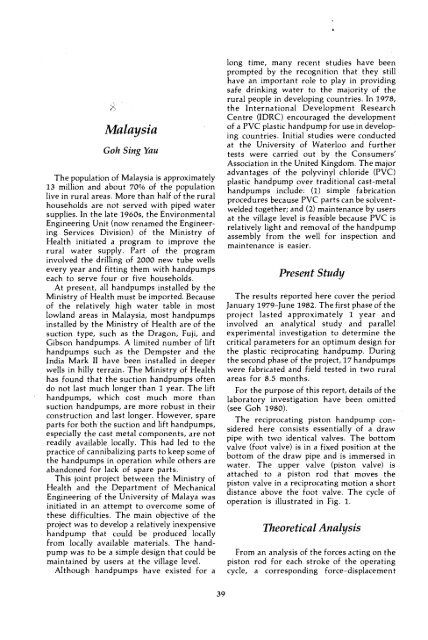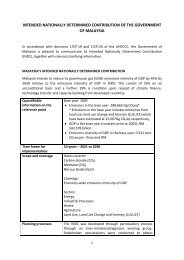RP-01638
RP-01638
RP-01638
Create successful ePaper yourself
Turn your PDF publications into a flip-book with our unique Google optimized e-Paper software.
Malaysia<br />
Goh Sing Yau<br />
The population of Malaysia is approximately<br />
13 million and about 70% of the population<br />
live in rural areas. More than half of the rural<br />
households are not served with piped water<br />
supplies. In the late 1960s, the Environmental<br />
Engineering Unit (now renamed the Engineering<br />
Services Division) of the Ministry of<br />
Health initiated a program to improve the<br />
rural water supply. Part of the program<br />
involved the drilling of 2000 new tube wells<br />
every year and fitting therri with handpumps<br />
each to serve four or five households.<br />
At present, all handpumps installed by the<br />
Ministry of Health must be imported. Because<br />
of the relatively high water table in most<br />
lowland areas in Malaysia, most handpumps<br />
installed by the Ministry of Health are of the<br />
suction type, such as the Dragon, Fuji, and<br />
Gibson handpumps. A limited number of lift<br />
handpumps such as the Dempster and the<br />
India Mark II have been installed in deeper<br />
wells in hilly terrain. The Ministry of Health<br />
has found that the suction handpumps often<br />
do not last much longer than 1 year. The lift<br />
handpumps, which cost much more than<br />
suction handpumps, are more robust in their<br />
construction and last longer. However, spare<br />
parts for both the suction and lift handpumps,<br />
especially the cast metal components, are not<br />
readily available locally. This had led to the<br />
practice of cannibalizing parts to keep some of<br />
the handpumps in operation while others are<br />
abandoned for lack of spare parts.<br />
This joint project between the Ministry of<br />
Health and the Department of Mechanical<br />
Engineering of the University of Malaya was<br />
initiated in an attempt to overcome some of<br />
these difficulties. The main objective of the<br />
project was to develop a relatively inexpensive<br />
handpump that could be produced locally<br />
from locally available materials. The handpump<br />
was to be a simple design that could be<br />
maintained by users at the village level.<br />
Although handpumps have existed for a<br />
long time, many recent studies have been<br />
prompted by the recognition that they still<br />
have an important role to play in providing<br />
safe drinking water to the majority of the<br />
rural people in developing countries. In 1978,<br />
the International Development Research<br />
Centre (IDRC) encouraged the development<br />
of a PVC plastic handpump for use in developing<br />
countries. Initial studies were conducted<br />
at the University of Waterloo and further<br />
tests were carried out by the Consumers'<br />
Association in the United Kingdom. The major<br />
advantages of the polyvinyl chloride (PVC)<br />
plastic handpump over traditional cast-metal<br />
handpumps include: (1) simple fabrication<br />
procedures because PVC parts can be solventwelded<br />
together; and (2) maintenance by users<br />
at the village level is feasible because PVC is<br />
relatively light and removal of the handpump<br />
assembly from the well for inspection and<br />
maintenance is easier.<br />
Present Study<br />
The results reported here cover the period<br />
January 1979-June 1982. The first phase of the<br />
project lasted approximately 1 year and<br />
involved an analytical study and parallel<br />
experimental investigation to determine the<br />
critical parameters for an optimum design for<br />
the plastic reciprocating handpump. During<br />
the second phase of the project, 17 handpumps<br />
were fabricated and field tested in two rural<br />
areas for 8.5 months.<br />
For the purpose of this report, details of the<br />
laboratory investigation have been omitted<br />
(see Goh 1980).<br />
The reciprocating piston handpump considered<br />
here consists essentially of a draw<br />
pipe with two identical valves. The bottom<br />
valve (foot valve) is in a fixed position at the<br />
bottom of the draw pipe and is immersed in<br />
water. The upper valve (piston valve) is<br />
attached to a piston rod that moves the<br />
piston valve in a reciprocating motion a short<br />
distance above the foot valve. The cycle of<br />
operation is illustrated in Fig. 1.<br />
Theoretical Analysis<br />
From an analysis of the forces acting on the<br />
piston rod for each stroke of the operating<br />
cycle, a corresponding force-displacement<br />
39



